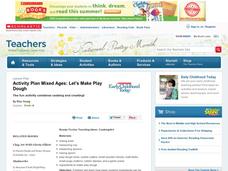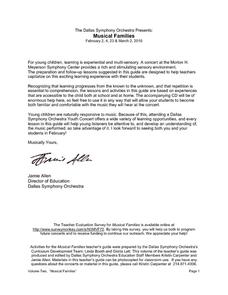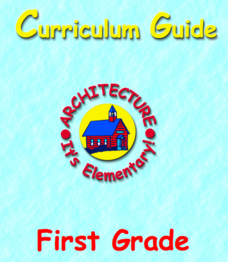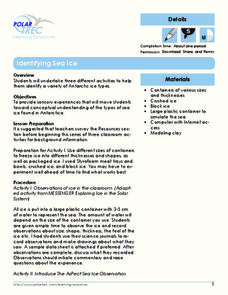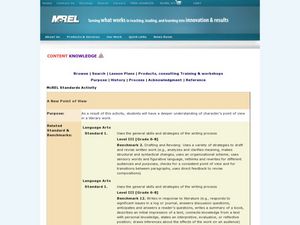Curated OER
Literature - Overview - May
Third graders study sayings and phrases, poetry and stories in this month's activities.
Curated OER
A Day During Colonial Times
Fifth graders participate in read aloud activities of three books about life in Colonial times. They compare their life to that of children of Colonial times using a Venn diagram. They draw a picture and write about what a day in the...
Curated OER
Lawton: A Child of the Prairie
Students complete word study activities, read a story and write a descriptive paragraph about the setting of Goo Goo Avenue in Lawton 1901.
Curated OER
Growing Eyeballs
Students investigate vision and the anatomy of the human eye. They complete a Webquest, watch a video about the structure of the eye, take an online quiz, answer discussion questions, and read newspaper articles about activities that...
Curated OER
Regional Differences
Pupils examine how the brain sends and receives messages by assessing PET scans. They diagram areas of the brain that evaluate various situations. They discover that individuality is due to different responsesnin the brain.
Curated OER
Found Poetry with Primary Sources: The Great Depression
Students read a sample found poem and create one together as a class. In this Great Depression lesson, students select a topic, such as miners, and read primary source documents related to the topic. Students select one narrative as the...
Curated OER
Let's Make Play Dough
Students create their own play dough to use for art projects. In this art lesson, students measure, pour and mix the ingredients to make their own play dough. Then, students use the clay to create their own sculptures.
Curated OER
Home Living/Daily Living: Selecting an Outfit
When people make clothing choices, they should be attempting to buy clothes that are the proper size. Unfortunately, for most that is a skill that they have never been taught. Make sure your special education learners can purchase...
Curated OER
Make it a habitat
Young scholars consider the adaptation of life forms through natural selection to fill various niches and accommodate changing environmental conditions. They select an ecosystem and conduct research to provide as much detailed...
Curated OER
Wood You Believe: Wood Products
In this wood products lesson, students walk to a forest near their school where they sit by themselves for a few minutes and quietly observe their surroundings. Students brainstorm wood or wood by products, discuss everything we get from...
Curated OER
Alphabetical Order
In this alphabetical order worksheet, students working in pairs or small groups match up letters of the alphabet to their images. Students then match up letters of the alphabet to market items (a-apples).
Curated OER
Art Criticism: Understanding Wayne Thiebaud's Salads, Sandwiches, and Desserts
Analysis consists of an understanding and interpretation of evidence and elements found in any number of expressive mediums. Upper graders critique the work of American Realist Wayne Thiebaud through a series of excellent guided...
Curated OER
Early English Settlement
Fifth graders encounter the TCI History Alive Assessment. Create a rubric together with other students. Use graphic organizers to brainstorm challenges that one would face attending school in a foreign country.
California Academy of Science
Fish Prints
What do a dead fish, conservation, and paint have in common? The answer is a great lesson about fish anatomy, fun print making techniques, and unsustainable fishing practices. The class will start by making fish prints with a...
Serendip
How Do We Sense the Flavors of Food?
We taste with our taste buds, so why do flavors change when we have a stuffy nose? Scholars experiment with taste testing while holding their noses and then while smelling. They record their observations in pairs and come together to...
Dallas Symphony Orchestra
Musical Families
Planning a trip to the symphony? Prepare first-time attendees for the experience with overheads that identify the roles played by the concertmaster, conductor, musicians, and even the audience. The musical families are introduced...
American Institute of Architects
Architecture: It's Elementary!—First Grade
Build an interest and appreciation for architecture in your young learners with this fun 10-lesson art unit. Engaging children in using their five senses, the class first observes the environment around them, paying...
Polar Trec
Identifying Sea Ice
Sea ice contains 17 sub-types based on age and various characteristics. Scholars observe ice floating in a simulated ocean and record their observations. Then, they view photographs of different types of sea ice and learn to...
Curated OER
The Princess's Point of View
Everyone wants to be part of a royal family. Let your pupils experience the privilege of royalty by rewriting the story The Frog Prince from the point of view of the princess. While the story line remains the same, perspective is bound...
Curated OER
Children's Playthings And Books
Students categorize studenT toys by intelligence types. They review toy safety and function and identify the appropriate play age of various toys. They read and evaluate studenT books and write one of their own.
Curated OER
Things Fall Apart: Research, Writing & Presentation Project
A great resource for your unit on Chinua Achebe's Things Fall Apart. Small groups conduct research about related topics (list included), write papers, present PowerPoint slide shows, and take a student-created test. Fill in a few...
Curated OER
A New Point of View
Analyze point of view and how it affects a literary work with this lesson. Middle schoolers create a written piece that focuses on point of view. They review the literary term "point of view," and explore examples of the term in text....
Gwinnett County Public Schools
Analysis of the Tuck Everlasting and The Birchbark House Text Exemplars
Looking to introduce some text-based questions into your ELA lessons? Practice the kinds of skills the Common Core demands with the seven text-based questions and the essay prompt provided here. Designed to be a three-day lesson, day one...
Utah Education Network (UEN)
The Pasture and the Fence
Beginning geometers use tiles and grid paper to draw and calculate perimeter and area. Rectangles of different sizes are created and then measured to build understanding. The one-inch grid sheet referenced is attached.
Other popular searches
- 5 Sensory Activities
- Sensory Activities Preschool
- Multi Sensory Activities
- Autism Sensory Activities
- Sensory Activities Easter
- Sensory Activities Sen
- Multi Sensory Activities
- Miltie Sensory Activities








